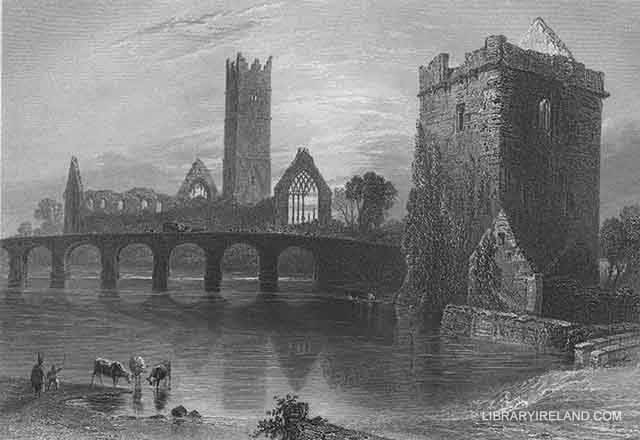Clare Abbey, Galway
We left the crowded and foreign-looking streets of Galway most unwillingly, and passed our afternoon in a visit to the fine ruins of CLARE ABBEY, beautifully situated on the banks of the Clare river, near its entrance into Lough Corrib. Thence we kept on our way to Athlone and Clonmacnoise.
The Shannon from Athlone to Clonmacnoise is a dull and uninteresting river. "Surrounded by bogs," to use the language of Caesar Otway, to whose sparkling and flowing pen we are indebted for this and other admirable descriptions, "it creeps through dismal flats and swamps; and the narrow tracts of meadow and small patches of cultivation along its banks, only tend, like green fringes to a mourning drapery, to mark off, as by contrast, the extreme dreariness of the picture. A tedious row of about ten miles down the most dreary of navigations, brought us in sight of Clonmacnoise. As I said before, a line of gravel-hills, forming the Aisgir Reada, comes from the east, and cuts the line of the Shannon at right-angles, causing the great river to form a reach or bend; and the hills, breaking their direct lines as they approach the stream, form an amphitheatre, upon the southern curve of which are erected the Seven Churches: the northern terminates in a beautiful green hill, like the inverted hull of a ship, round which the river flows at some distance, leaving an extensive flat of swampy meadow between it and the water.
As the wind was strong and steady here up the river, causing the labour of rowing to be almost intolerable, we drew up our little cot into a cave, and ascending the green hill, had at once from its summit a view of the sacred spot before us, and of the extraordinary country all around. The Irish saints of olden time, in imitation of their brethren of the Thebaic desert, chose places wherein to honour God and discipline themselves, which marked the austerities of that superstition, which deceivingly told them that they must not stand up to make use of the liberty therewith Christ had made them free. What a dreary vale is Glendalough!—what a lonely isle is Inniscaltra!—what a hideous place is Patrick's Purgatory!—what a desolate spot is Clonmacnoise! From this hill of Bentullagh, on which we now stood, the numerous churches, the two round towers, the curiously overhanging bastions of O'Melaghlin's Castle, all before us to the south, and rising in relief from the dreary sameness of the surrounding red bogs, presented such a picture of tottering ruins and encompassing desolation, as I am sure few places in Europe could parallel.

